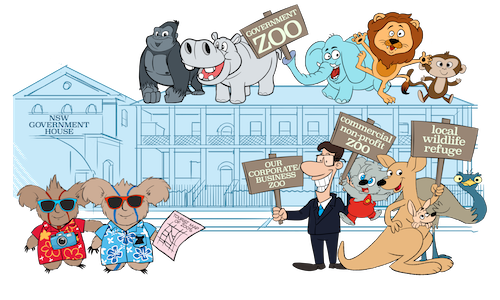Types of Zoological Parks
This article is part of a series. If you missed Part One, please click here.
The three traditional types of zoological parks (zoos) are listed below. The fourth is the new, emergent type of zoological park; a recent evolution of the wildlife park that has witnessed the commercialisation of the traditional non-profit models.
1.) Government-based zoos
2.) Corporate-run/Large wildlife parks/zoos
3.) Small local zoo/ Wildlife Refuge/Non-profit zoos
4.) Social Enterprise (
Government Zoos
(Overseen by Australian State or Territory Government)
Government-run zoos in Australia have the highest form of regulation which means the zoo is more conservatively managed. These zoos manage hundreds of staff and thousands of animals. Government-run zoos are usually located in close proximity to a city centre. These zoos were established when the Australian population was relatively small and the design of the city was
Increasing human population and rapid urbanisation
Disadvantages
However, this approach can work against certain species of animal. As the government-run zoos expand and become more conservative and commercial, they find ways to cut costs, which usually comes at the expense of the animals and dedicated staff members. Such zoos are more willing to employ management with a background in business and commerce, who have little to no history or experience working in animal care. These decisions mean that loyal and devoted employees with a huge amount of animal husbandry experience and knowledge of the overall business operations and communications are slowly replaced in the zoo, and then, across the industry. This ultimately
Large government-run zoos have become highly departmentalised, meaning, the roles of the staff are segmented into strict departments. For example, the horticulturalists will collect all of the animals' food (including koala food) and will not venture into the enclosure reconstruction department, and will
Suggestions
Government-run zoos should implement a more holistic approach to staff training and development and work to broaden job descriptions so that staff are able to spend time working across multiple sectors within the zoo.
Government-run zoos should not be fixed in one location, but rather, they should work toward implementing a 'moving' or 'mobile' zoo which would share elements of a free-range zoo, having land that is at least 10,000 hectares long. This new type of zoo would be sprawling throughout Australia's vast countryside and would be suited to allow for migrations for various large, exotic animals to roam free (or freer than they currently are). This vision would also need to be developed with input from urban developers so that it can evolve with Australia's urbanisation. This would be a similar concept to an African Safari
Corporate-run Zoos/Wildlife Parks
(Private, non-government)
Corporate-run/big business zoos (or private zoos) follow many of the same rules and structures as government-run zoos, particularly in terms of their staff structure. In fact, many staff move from the government-run zoos to corporate zoos for higher pay or a higher position. However, many corporates tend to buy zoos only for the purpose of revamping and refitting them in order to sell them off to the next buyer for a profit. This means that the corporate zoos/wildlife parks can change ownership every few years.
Disadvantages
Though corporate zoos/wildlife parks can be a little more flexible than government-run zoos, they hit the same
Suggestions
The Board members of
Corporate zoos/wildlife parks should work alongside government zoos to support the implementation of elements of a free-range zoo, having land that is at least 10,000 hectares long. They should also support the transition phase from when a zoo moves from a fixed position to a 'moving zoo'. Both the private and public sector, and government and corporate/wildlife park zoos should be working with urban developers to evolve with modern infrastructure development that has a positive impact on both humans and wildlife.
Small local zoo/ Wildlife Refuge/Non-profit zoos
(This may include sanctuaries, native wildlife parks, or wildlife parks and can be government run, private and usually locally-run)
Small or local zoos are built for a variety of reasons, however, usually, they are built out of necessity, perhaps from an increase in animal injuries, a bushfire or natural disaster, or to care for local animals that have been in road injuries. These wildlife parks have the potential to operate successfully, however, many are built out of an emotional response rather than practicality, and will fail due to inept management.
In terms of daily operations,
Disadvantages
However, the drawback from small to medium size zoos is the fact that staff do, almost always, reach a certain point in their lives where they may notice a bottle-neck of staff trying to aim higher and wish to leave the industry and pursue a career in the bigger institutions.
Suggestions
Small/Local Parks should collaborate with larger government and corporate run zoos. This will ensure that there is greater knowledge-sharing and would encourage greater commitment to the long-term goals of the entire zoological industry.
Social Enterprise (
The non-profit zoo (or wildlife refuge) usually starts with humble and idealistic ambitions; their main aim is
While these institutions play an important role in koala protection, they often use exaggerated messages or victimise the koala to illustrate their point.
Looking Forward
Every style of
The government-run institutions have the potential to become more progressive and less conservative and departmentalised. This change would inspire corporate/bigger wildlife park-type zoos to follow their lead and embrace long-term investors instead of small term investors, who would see
To me, the local wildlife park/sanctuary is like little athletics, or junior football; building the skills of the future. It is a place that plays just as important of a role as bigger institutions.
In Part 3 we explain Inside-Out and Outside-In the Koala Industry.

